And a Free Video for You!This summer, I created a poll on instagram to ask you about your experiences with savasana: Do you practice it? What's the easiest part about it? The hardest? Did it change after your loss? I got lots of replies. Here is a summary. Do you practice it? Yes and No. Some practice it regularly. Some did and don't any more. Some don't. The reasons for not include: not having the time (even though you know it helps, it's hard to make the time for it), and being fearful of what will come up during the pose (primarily emotion). For the ones that do, repeated and consistent practice was helpful in releasing chronically held tension. However, even with this knowledge, maintaining a regular practice of savasana was a challenge. What's the easiest? Some reported a feeling of relaxation: "Sinking into the earth," while other reported other things like crying or sleeping. The hardest part? Almost everyone reported the swelling of emotion or the activity in the mind being the hardest part about the pose. Finding the courage to do it was another. A couple of people mentioned the name - Corpse Pose - being disturbing enough that it was a barrier to their practice...and when the name corpse pose was used by a teacher loosely during a class, the practice became triggering, unsettling and unsafe. Did the practice of savasana change after loss? With this question I was hoping to glean information around the effect that grief had on one's ability to relax. For most, it did change after loss - in the ways mentioned above. For some, they had never practiced it before, so post-loss it was a new experience. What have I noticed as a grief-sensitive yoga teacher? In my experience, teaching yoga as a supportive practice for grief, I've noticed how important savasana and relaxation are to living with loss. So important in fact, that I weave the essesnce of savasana into the entire class. The relaxation of effort that one finds in savasana isn't only present in the last 3, 5 or 10 minutes of class, but it is part of the entire experience of yoga asana and mindfulness throughout, especially when it comes to coping with difficult states of mind and emotion. To me, savasana is an orientation to yoga. An emotional stance towards your practice. This pose embodies the nature and purpose of the entire practice. And yet, when I go to "regular" yoga classes, savasana is skimmed over, or worse, skipped completely. If it's not, the guidance is around relaxing the body, with less advice on dealing with mental tension, and usually NO advice on how to deal with emotional release during the pose...which is a very a common experience of those grieving. And so, this important pose - one that embodies the heart of yoga, and is exceptionally helpful to those experiencing ongoing states of suffering - becomes one that is avoided and misunderstood. That is why I created this video. I believe that savasana should be taught and practiced with the same depth of technique as headstand or a fancy arm balancing pose. I believe that the teaching of it should include, not only the body, but information about how to consciously relax the mind, as well as the emotions. And it's not simply "letting go" (a phrase that in its popularity has seemed to lose any real meaning). It's more about becoming deeply aware of your states of mind and emotions, and from there, working wisely with them. So, I hope you enjoy this video. The first 10 minutes are a preamble about why savasana is hard. I recommend you listen to it and take some time to reflect on how our modern and western view of relaxation has shaped your experience and ability to relax. For the practice, you will need a couple of blankets - one rolled up for behind your knees (or a bolster) and one folded for your head (or a small pillow). It may also be nice to have a blanket to cover up with. If you want to explore some of the topics I mention in this video, I have numerous blog posts on the subject: Namaste,
Sandy
0 Comments
Savasana is a pose of conscious relaxation. Although many people fall asleep while practicing savasana, that is not the aim of this pose. In Light on Pranayama, B.K.S Iyengar says, “Some call it the Eternal Now, beyond space and time. Others call it the soul becoming one with the Creator. This can be experienced in perfect savasana when the body is at rest as in deep sleep, the senses as in a dream but the intellect alert and aware.”
Savasana is a restful pose, and the outcome of it is recuperation and rejuvenation. Sleep, however is not always restful, and it's possible to even wake from sleep and not feel rejuvenated. Why is this? Studies have been done that measure the brainwave activity of those people who practice conscious relaxation and found that alpha waves (slow brain waves) increase in intensity and frequency during the practice. Interestingly, in similar studies done on sleep, these alpha waves are not commonly found during sleep, or aren't an overarching and ever-present component of sleep. During sleep, the brainwave pattern changes depending on the depth and stage of sleep. Further, sleep can be un-restful due to insomnia, vivid and disturbing dreams, frequent waking etcetera, etcetera. With meditation and conscious relaxation however, the brain kind of downshifts to an idle, the alpha state, where sensory input is less, awareness is internal, and the brain is in a state of non-arousal. Alpha brainwaves are the resting state of the brain, and aid in contemplation, reflection, mental coordination, calmness, mind/body integration, learning and creativity. Practicing meditation and savasana nurture the alpha state. With regular practice, the practitioner to more easily and readily achieves the alpha state. Studies have also shown that practices that employ alpha brainwave activity may have a regulatory role on sleep, meaning that people who practice conscious relaxation and meditation, sleep more deeply and more restfully when it's time to sleep. As I've said before, savasana isn't about sleeping...but so often, people do fall asleep in savasana. If you aren't getting enough sleep, or enough restful sleep, falling asleep in savasana would make sense. My yoga teacher used to say, "if you fall asleep, you need the sleep." So true. Sleep obviously has it's benefits: physical recovery, cognitive organization, improved ability to concentrate and learn, memory, and mood regulation to name a few. But, as the buddhist saying goes: "If you walk, just walk. If you sit, just sit; but whatever you do, don't wobble" - when it's time to sleep, sleep well and when it's time to relax, relax well. As I've mentioned before, savasana is a practice. If you find you are falling asleep, try shortening the time you are in savasana. Decrease it from 10 minutes to 5 minutes to work on developing the ability of the mind to stay focused and alert without falling asleep. The more you can train your body to be still, and your mind to downshift and idle in a relaxed state, the more easily and often you will stimulate the relaxation response, thereby making it more accessible. Overtime, your ability to stay consciously relaxed in savasana will improve, and perhaps your ability to sleep deeply at bedtime will improve as well. Restfully yours, Sandy "First, learn to achieve the silence of the body. Then control the subtle movements of the breath. Next learn about the silence of the mind and the emotions and then of the intellect. From there proceed to learn and study about the silence of the Self. It is not until then that the ego or small self (ahamkara) of the practitioner can merge with his self (Atman). The fluctuations of the mind and the intellect cease, the 'I' or ego disappears and Savasana provides an experience of unalloyed bliss." - Light on Pranayama, page 233
I was in a class once, and at the end, the teacher announced it was time for savasana. She invited us all to stay in savasana for as long or as short as we would like, and then walked out of the room. The only direction she gave, was to be quiet as you were cleaning up your mat. Could you imagine doing this for any other pose in a yoga class? This story highlights the lack of attention given to savasana. Just like any other pose in yoga, savasana deserves attention. In this post, I'll go into more detail about how to do savasana, which then, you can continue to practice. (See my last post about how savasana is a practice).
Time and place
First learn to silence the body
Then, the senses (This is the fifth of the eight limbs of yoga - pratyahara - turning the senses inward).
Then control the subtle movements of the breath
Then the mind, emotion and intellect
Coming out of savasana
Taking it off the mat
Namaste, Sandy "In correct savasana there is minimum wastage of energy and maximum recuperation. It refreshes the whole being, making one dynamic and creative. It banishes fear of death and creates fearlessness. The sadhaka experiences a state of serenity and inner oneness." page 254 (Sadhaka - A seeker, an aspirant)
Reference
Light on Pranayama: The Yogic Art of Breathing by B.K.S Iyengar "By remaining motionless for some time and keeping the mind still while you are fully conscious, you learn to relax. This conscious relaxation invigorates and refreshes both body and mind. But it is much harder to keep the mind than the body still. Therefore, this apparently easy posture in one of the most difficult to master." B.K.S. Iyengar.
I started this post about savasana to be a short newsletter. Quickly, though, I realized that there is so much to this pose than it appears and my "short newsletter" has become multiple blog posts. How? You may ask. How can a pose that is 'just laying there' require so many words and explanations?
There are a few reasons for this:
I'll explore all of these reasons in this series, but I'll start with one of the primary misconceptions: It's actually called Corpse Pose This one may not be a misconception, but a misnomer. Calling savasana a relaxation pose is accurate, but 'relaxation' is not the direct translation of the word savasana and as such, it doesn’t really capture it’s entire meaning. I am guilty of side-stepping this actual translation and purposefully calling it "Relaxation Pose." I do this because I am sensitive to the fact that it might be a trigger for some people in the grief support group, especially without more context about the deeper meaning of the name. As with other aspects of grief and emotional awareness, authenticity and calling something what it actually is can be helpful. So I explored it, which is how this post came to be. I found what B.K.S. Iyengar says about savasana in Light on Pranayama to be enlightening: “Sava in Sanskrit means a corpse and asana a posture. Thus Savasana is a posture that simulates a dead body, and evokes the experience of remaining in a state as in death and of ending the heart-aches and the shocks that the flesh is heir to. It means relaxation, and therefore recuperation. It is not simply lying on one’s back with a vacant mind and gazing, nor does it end in snoring. It is the most difficult of yogic asanas to perfect, but it is also the most refreshing and rewarding.”
"Ending the heart-aches and shocks the the flesh is heir to."
I know that for myself, I was always oddly perplexed that I was doing 'corpse pose' when death was so front and centre in my life. The way I reconciled the name corpse pose with practicing it after a death, is that it was a practice of complete and total surrender (surrender: to cease resistant to). I found it easy to cease resistance to the fatigue I felt in my body and to slip into the stillness and silence of savasana. Mentally surrendering to the reality that grief eradicated my life as I knew it felt congruent because so many parts of me died when Cam died. The hard part was the SURGE of emotion that would spontaneously arise, making the supposed-surrender all the more complex and at times seemingly impossible. It did not feel like 'relaxation' as suggested by the Iyengar in the quote above. He says, "remaining in a state as in death and of ending the heart-aches and the shocks that the flesh is heir to." Before you can end the heart-aches and shocks (maybe 'live-well-with' is a better word than end?) you must experience them in a way that integrates the heart-ache and shock reality into our life. Feel it to heal it. When Iyengar says "ending" the heart-aches and shocks" I don't think he means permanently ending. We are human after all, and of course, heart-aches and shocks will happen throughout life whether we want them to or not. I think he means that in between the surges of thought and emotions there are moments of complete and total stillness that are void of thought, emotion and suffering. It is in these moments that you can truly relax. The practice of savasana is to cultivate the ability to stay conscious of everything that is going on within you so that you can learn how to extend those spaces of stillness a little longer each time. Becoming still in the body and witnessing the impermanence and flow of thoughts and emotions is the doorway to conscious relaxation. More broadly, savasana teaches you how to manage life's ups and downs with less reactivity and more equanimity. Another way to look at corpse pose is seeing it as the conscious awareness of death, and how parts of you and your life "die" everyday, especially after a major loss. Savasana, as a daily (or often) practice is quite literally, the practice of dying everyday; letting go of what we can let go of (like the constant and sometimes unhelpful chatter of the mind, for example) and appreciating some of the deeper chords that link us to life (awareness of the preciousness and fragility of life and relationships). At the end of savasana when you slowly begin to move your body and deepen your breath, you are symbolically "beginning again." This idea of continually re-opening or re-beginning is a major part of integrating your yoga practice into your life and feeling recuperated from it. “We die a little every day and by degrees we’re reborn into different men, older men in the same clothes, with the same scars.”
Regardless of what happens in savasana - you sleep, you cry, you think your head off - doing it with awareness and the intention to practice conscious relaxation is the most important part.
I hope you've enjoyed my take on corpse pose and I'd love to hear what you think. Feel free to comment below. Stay tuned for the next post where I will look more deeply at savasana as a practice.
Through out this post I've referenced Light on Pranyama by B.K.S Iyengar. There is a wonderful chapter in the book on savasana and I recommend it as a resource.
Another one of my favourite books which looks at relaxation in a broader, more practical "off the mat" sense is Sabbath by Wayne Muller.
There is a difference between a broken heart and a heart broken open. The broken heart is real but leads to a shutting down on life. The heart broken open creates the possibility for light to filter in. In that open space, there is room for compassion and tenderness to grow. In the end, choice helps to shape your experience. Choose to let your heart be broken open and see what remains to grow. - Ashley Davis Bush  I resonate with the work of Ashley Davis Bush and find her to be so affirming and loving in sharing her wisdom. When I saw the quote written above on her Facebook page and it made me think of all the heart opening practices there are in yoga. Slowly and gently yoga invites you to notice your heart. To breathe into it, and to create space in it. Enough space to hold all the hurt and all the love simultaneously - perhaps this is what being broken open means. Connecting with the heart's brokenness and openness creates compassion and understanding, and from there, choice. Choice to treat yourself compassionately, choice to make decisions that are life giving and self supportive. There can be wisdom and guidance in a heart broken open. Below is a short heart opening sequence. As you move through this practice be open to how your heart is communicating with your mind and body. Notice what thoughts present themselves to your mind. Notice your emotional reactions to them. Notice the subtle (or not so subtle!) sensations in the body. This practice isn't about solving or changing anything. It's simply about connecting and opening to the wisdom and awareness that can reside in a heart broken open. Trust yourself. 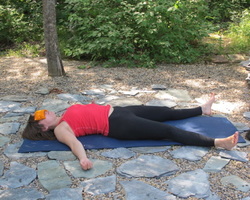 Start in savasana. This is my favourite way to start class. Use this time as a time to transition from living your day outside yourself (as is often the case with jobs, families etc) to a "yoga space." A time of awareness and connection with yourself. Allow your body to settle, and bring your awareness to what you are experiencing on the inside. Take this time to allow your mind to settle on the breath, noticing its rhythmic flow, constancy, and availability. There is no rush. Take time to slow down. Take time to practice being open to and with your heart. Bend your knees and roll onto one side. Resting there for a moment. Pressing up to sitting and setting up for a deeper heart opening pose. For this pose you will need two blankets, folded so it resembles a long skinny rectangle. Set yourself up so that one folded blanket is placed towards the head of your mat, around where your shoulder blades will be. Have the other folded blanket to place under the knees.  You will lay back on the blanket so it touches the shoulder blades. The shoulders must be above the blanket, so the shoulders can release towards the floor. Notice in the photo how my arms can easily fit above the blanket and the blanket is placed below the arm pits. **If the shoulders are resting on the blanket, it will not allow your heart to open. Place support under the head if your chin is lifting up, or if there is tension in the neck or throat. Allow your upper back and knees to gently cascade over the blankets...hence the name, waterfall pose; Imagine water as it flows over rocks in a stream, smoothly and softly. Breathe into your heart. Inhale and swirl the breath around your heart with the intention of having the breath nurture and explore the heart. Exhale and relax, sink, soften. Inhale and swirl, nurture, open, explore. Exhale soften. To move out of this pose, roll over to one side and press up to sitting.  Next, move yourself to a wall. Have your folded blanket ready to use, or a bolster. The easiest way to get into legs up the wall pose is to sit beside the wall right hip and thigh is parallel to the wall. Turn to lay down on your back and swing your legs up the wall. Spend a few moments here, allowing your body to adjust to this position. There is no hurry. Slow down. Bend your knees and place your feet on the wall. Lift your hips up off the floor and slide your blanket or bolster underneath your hips. You want to feel stable here so adjust the props as needed. Roll your shoulders together behind your back and press them into the floor so your breast bone lifts towards your chin and your chest and heart is open. Breathe into the openness of your heart - the center of your chest. As you inhale expand the breath to both shoulders. Exhale and soften. With each in-breath expand the breath further: from the center of your heart to both shoulders and eventually down the arms and into the hands. When you are ready to come down: place the feet on the wall and lift the hips. Remove the bolster or blanket and roll down one vertebrae at at time. This can be a really nice release for the back so move slowly and care-fully. Once your hips are back on the floor, rest. Staying in legs up the wall is a nice way to end the practice. Or, stretch out, lay flat (as in the start) and rest. For the first 10-20 breaths of savasana focus on breathing light into the heart. You can imagine a warm glow or a candle flame. As you inhale, imagine that light growing brighter. As you exhale maintain a sense of a light inner body. Inhale and grow the light brighter. Exhale and maintain. "The heart broken open creates the possibility for light to filter in." - Ashley Davis Bush. Namaste, Sandy  I am proud to announce that I have a relaxation CD for sale! I created this CD as an audible relaxation practice - that can be done in your own way and your own time. It's another way that I hope to bring the practice of yoga off the mat and into daily life. Savasana is the final relaxation pose in every yoga class - the act of complete and conscious surrender of the mind and body. I joke that this is the hardest pose in all of yoga - if you've ever had trouble falling asleep or relaxing you know what I mean. The body must relax in order for the mind to relax, and the mind must relax in order for the body to relax. Savasana is a holistic practice. Practice being the key word. It doesn't always come easily. However, as with many tools we have in our "toolbox of life," conscious and mindful relaxation is something we can learn and cultivate with practice. This CD is about an hour long, and made up of 3 separate tracks which are about 20 minutes each. It can be done as an hour long relaxation session, or you can choose one of the three 20 minute practices. The tracks are guided relaxation, so you just have to turn on the CD, lay down and follow the voice guided instructions. The benefits of relaxation run deep. It is the natural antidote to stress, and further to that, the antidote to the effects stress has on the body and mind. Relaxation lowers the heart rate, and blood pressure. It slows and deepens the breath. It has an synergistic effect on the nervous system - balancing out the sympathetic (fight or flight) and the parasympathetic (rest and restore) nervous systems. This leads to improved sleep, better immune function, improved digestion, and higher energy levels. It can also help to decrease feelings of anxiety and panic, and increase feelings of clarity and creativity. In a society where stress runs rampant, and in lives where loss creates high levels of prolonged stress, relaxation is an invaluable tool. You can find the CD to purchase here. Or just click on "store" tab above. The CD can be purchased as an MP3 file for 9.99 or you can purchase the compact disc for 14.95 plus shipping fees. "Light be the earth upon you, lightly rest." - Euripides (484 BC - 406 BC), Alcestis, 438 B.C. Namaste, Sandy One day after class, a student commented that she was finding the class helpful, but couldn't remember anything we had done once she was at home.
I should have known!!! I know that one of the major symptoms of grief is changes in memory, so it should have occurred to me to provide some written information for each student! With this feedback, I started sending an email after each class to all the students, which includes some of the highlights from class. It is a win-win. I know the information is appreciated, and I love sharing what we learn in a way that it can be used off the mat, and in daily life...because the real yoga practice begins when you leave the studio. Here is an example of a weekly email.... It’s been a really long time since I’ve read a yoga book front to back, page to page, in an I-can’t-put-this-down- fervor. I usually flip to a section that speaks to me, or read something that I want to know more about, especially if it is a yoga resource book. Until, “Yoga as Medicine” by Timothy McCall. I have thoroughly enjoyed reading this book, and would recommend it to everyone who is doing yoga to improve their mind, body and spirit. For me, yoga has always been more that just a physical practice. I would describe it more as a mind/spirit practice that has a positive effect on the body! What I love so much about this book is that McCall describes the far-reaching benefits of yoga in regards to all three (mind/body and spirit) so clearly and succinctly that yoga don’t view any of them as separate or distinct. You learn about yoga as an absolutely integrated practice, which is what it has always been, and is exactly where its deep benefits are found. Yoga as Medicine begins with introducing yoga as a form of healing, and as an approach to medicine that is used to benefit the healthy as well as the sick. McCall compares the integrated practice of yoga to the western approach to medicine, and states that it is yoga’s different view that makes it so effective. McCall is an MD, and has seen the benefit of integrating a holistic practice like yoga to complement conventional medical care. McCall’s take on yoga is one that is about “optimizing the function of every system in your body from the muscles to digestion, circulation and immunity. It is about emotional well-being, spiritual resilience, and buoyancy, even joy. Yoga teaches that only when these elements are aligned can you maximize your chance for health and healing” (page 4). There are many things that I love about this book, but to be more specific, I especially love: 1. How McCall is not partial to one style of yoga. He starts to book by describing many different styles of yoga from Iyengar to viniyoga to hot yoga –all with their pros and cons, but more importantly, stressing that no one yoga practice can be prescribed for an entire population. For example, there is not one yoga style or pose that everyone with back pain should do. It is completely dependent on the person, their injury/illness or need, and an educated assessment as to how to maximize function and benefit and minimize risk of injury. I love how individualized and person-centered McCall’s writing is, and his broad understanding of yoga. 2. McCall writes about yoga from a “multi-limbed” perspective in a way that is easy to read and easy to understand. Throughout yoga as medicine, McCall discusses the benefit of yoga from more than just the physical practice. He, of course, outlines physical poses that could be beneficial, but also consistently talks about the need to see yoga as a practice of many “limbs” – including breath work, self-study, ethical and moral observances, concentration and meditation. 3. Experience and Research. Throughout the book, McCall outlines research studies that have taken place that have looked at the effect of yoga on various illnesses/injuries including, cancer, arthritis, back pain, chronic fatigue, insomnia, high blood pressure and many more. He also has case studies in each section, which take a real life example of someone who has practiced yoga as a method of healing with their real-life accounts of the effect it has had. I appreciate this combination of research and experience, as it seems to make a stronger case for the benefit, especially in our culture where we are so scientifically orientated and research based. If you are interested in having a yoga book in your library that is a resource manual for understanding yoga as a multi-facetted practice that has healing benefit this is your book. Whether or not you have any of the conditions listed in the index, this book is an invaluable resource to understanding the subtleties of yoga as a mind/body/spirit practice. I have this book in my Yoga for Grief Support store. From the “resource page,” scroll down until you see the store. Timothy McCall’s Yoga as Medicine can be found there. Further, Timothy McCall has a great website - you can read more about him and his work here. Readers, I would love to hear your thoughts on how yoga has been medicine for you... Namaste, Sandy I recently bought a sandbag for my home yoga practice, and to use with one-on-one students. Sandbags are often used to add weight to a pose, or to give external pressure to our bodies as a way of cueing and /or to provide our bodies with feedback. Recently, I brought the sandbag back into my yoga practice. I was craving it’s weight; it makes me feel more grounded and solid. A yoga sandbag is literally a 10lb sandbag – dressed up in cute fabric: Often in yoga poses, we talk to our bodies in a way that makes them feel the ground with more awareness. Sensing our limbs pressing into the ground, and the rebound effect of elongation, length and strength we get from this. We pay attention to how we stand, sit, or lay, so we can feel rooted or connected to our physical body, and beyond that, to the earth. It’s this connection that allows us to stand taller and more firmly – literally and metaphorically. Standing “in our truth” is the essence of “grounding” ourselves. This is where a sandbag can be helpful – it’s added weight gives the body more of a sense of sinking into itself. It helps us be more rooted and grounded. In some poses, adding a sandbag is like having a teachers hands guiding you to move deeper. It can help to teach what feeling physically grounded feels like. Maybe my craving for a yoga sandbag comes from my obsession with magic bags. I love magic bags. Partly for the warmth, and partly for the weight. Granted, it’s not 10lbs, but it’s enough to feel a little more secure, and a little more comforted. I suppose the sandbag is like the Yoga Magic Bag! I found a great article from the Halfmoon Yoga Product blog, that has photos, descriptions and precautions for using a sandbag in a variety of postures. My personal favorite is legs up the wall with the sandbag on my feet. Have you tried a sandbag in your yoga practice? Share your thoughts.
Namaste, Sandy Last week, I asked a question on my Yoga for Grief Support Facebook page, asking readers what yoga pose was the most soothing. The most common response was child’s pose. So, I thought I would write a post on everything-child’s-pose!  Child’s Pose Childs pose is also called balasana and/or adhomukha virasana. Start by kneeling on the floor. Bring your big toes together and widen the knees, so they are about as wide as your hips. Extend and lay your torso down between your thighs. The forehead comes to rest on the floor. You can reach the arms forward with your hands comfortably shoulder width apart (top figure to the left) or you can lay them along side your body with the palms facing up and your shoulders released towards the floor, widening the upper back (middle figure to the left).With the torso resting on the thighs, and your forehead supported on the floor, child’s pose is very restful. It calms the mind and soothes the eyes and reduces stress and fatigue. Child’s pose can help relieve headaches, dizziness, and breathlessness. It can also help with symptoms associated with menstruation. Child’s pose is also considered a forward bend, and gently stretches the ankles, thighs and hips. It also can relieve tension in the back and neck when it is done with the head supported. With the arms extended, child’s pose gently stretches the long muscles of the back, shoulders and arms. If you have limited motion in the knees (osteoarthritis, knee injury) or ankles, you may require a modification. For stiff knees you can place a bolster or large rolled blanket under the hips and on top of the lower legs and heels to decrease how much bend is required in the knees. For tight ankles that don’t flatten against the floor, a smaller rolled blanket or towel can be placed under the ankles to offer support. Also, blocks, pillows, or a blanket can be used to support the head if it doesn’t easily rest on the mat. Some other variations that can be quite soothing and supportive are pictured below: In the first photo, the body is supported by a stack of bolsters or blankets. Build the stack high enough that you can comfortably rest on the bolsters and relax your legs, hips and shoulders. You can turn your head to the left or the right, just be sure to change the position to the other side to balance the stretch in the neck. This modification would be helpful if you have tight hips, as it decreases the amount of bend, by raising the height of your torso. You could also set up your bolster with a lift (as pictured below) so you can wrap your arms around the bolster, which you might find comforting. Also, a blanket or sandbag on the pelvis can provide a gentle way to relax and deepen into the pose. Another variation that does not require much equipment is the chair variation…..which can be a great way to relieve stress and tension from the back of the body. Let your head, arms and torso drape over your thighs. This modification would be appropriate for people who find child’s pose uncomfortable on the knees, shins and ankles. Breathing and Calming the Mind
Child’s pose is an excellent pose to feel the breath, as you can feel the movement of the chest and abdomen against the thighs as you breathe. When you can feel the body move with the breath you add another dimension to your breathing experience thereby making it more conscious. Due to the position of the back, you may also feel the breath expanding the back of the body. This is an excellent way to breathe in child’s pose – directing the breath to the back of the body – inhaling and feeling the expansion of the lower back, elongating the muscles along the spine, and broadening the shoulder blades. With the exhalation, soften your body, and let it surrender to the support of the floor or your props. Breathing with a lengthened exhalation can help to calm your nervous system. Count the length of your in-breath, and then try to make your out-breath a little longer – without creating tension in the breath, jaw and face. Smooth, easy, deep breathing. With the forehead supported, it can be especially calming to use the pressure of your forehead on the ground to push the skin towards your eyes – essentially helping to close your eyes (moving the opposite direction would be opening the eyes, which would be more stimulating). Again, doing this gently so you don’t create added tension or discomfort. In child’s pose, as we curl ourselves into a naturally comforting position, we are figuratively (and literally, I suppose) turning ourselves inward. This position of introspection has great healing potential and can be a source of strength to be true to yourself. Child’s pose is an expression of simplicity, innocence and rest. You can read more about forward bends here. |
AuthorSandy Ayre Categories
All
Archives
December 2022
|
Classes
|
Helpful Info
|
|




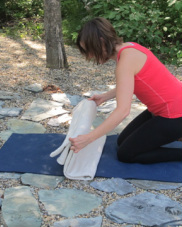

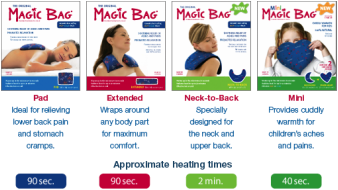
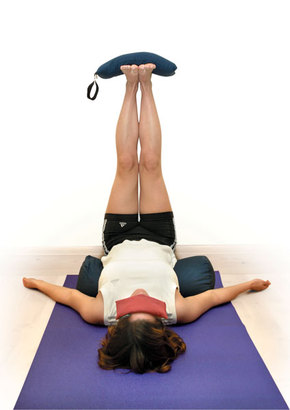
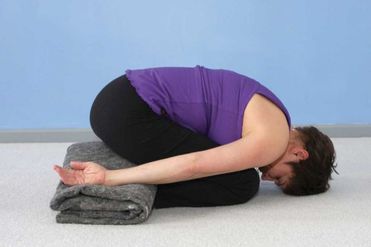
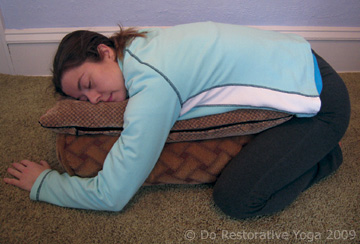
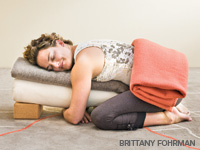
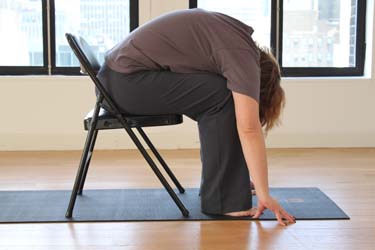
 RSS Feed
RSS Feed
